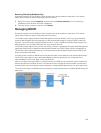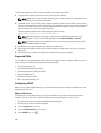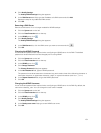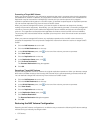Once a partner relationship is established, replication is bi‐directional. One system could hold target NAS
volumes for the other system as well as source NAS volumes to replicate to that other system.
A replication policy can be set up to run according to a set schedule or on demand. Replication
management flows through a secure SSH tunnel from system to system over the client network.
To access or recover data, you can promote a target NAS volume to a recovery NAS volume and grant
clients access to the recovery NAS volume data. The recovery NAS volume will appear as a local NAS
volume.
Target NAS Volumes
A target NAS volume is a read‐only copy of the source NAS volume that resides on the target FluidFS
cluster. The target NAS volume holds identical system configuration information (quota rules, snapshot
policy, security style, and so on) as the source NAS volume. You can promote target NAS volumes to
recovery NAS volumes temporarily or permanently and grant clients access to recovery NAS volume data.
The following considerations apply to target NAS volumes:
• Unlike source NAS volumes, you cannot create snapshots of target NAS volumes.
• There must be sufficient free space on the target FluidFS cluster to store the target NAS volumes.
• The system retains only the current replica of the source NAS volumes. To roll back to a previous
point in time, you must use snapshots.
• You can either replicate the source NAS volume to an existing NAS volume or to a new target NAS
volume. If you replicate to an existing NAS volume, the NAS volume must not contain any data you
want to retain. Any data residing on the NAS volume will be overwritten and cannot be recovered.
• Target NAS volumes count towards the total number of NAS volumes in the FluidFS cluster.
Managing Replication Partnerships
When replicating a NAS volume to another FluidFS cluster, the other FluidFS cluster must be set up as a
replication partner. This is a bi‐directional replication trust—source NAS volumes and target NAS volumes
can be located on either system.
Adding a Replication Partnership
Add a replication partner before configuring replication.
136


















